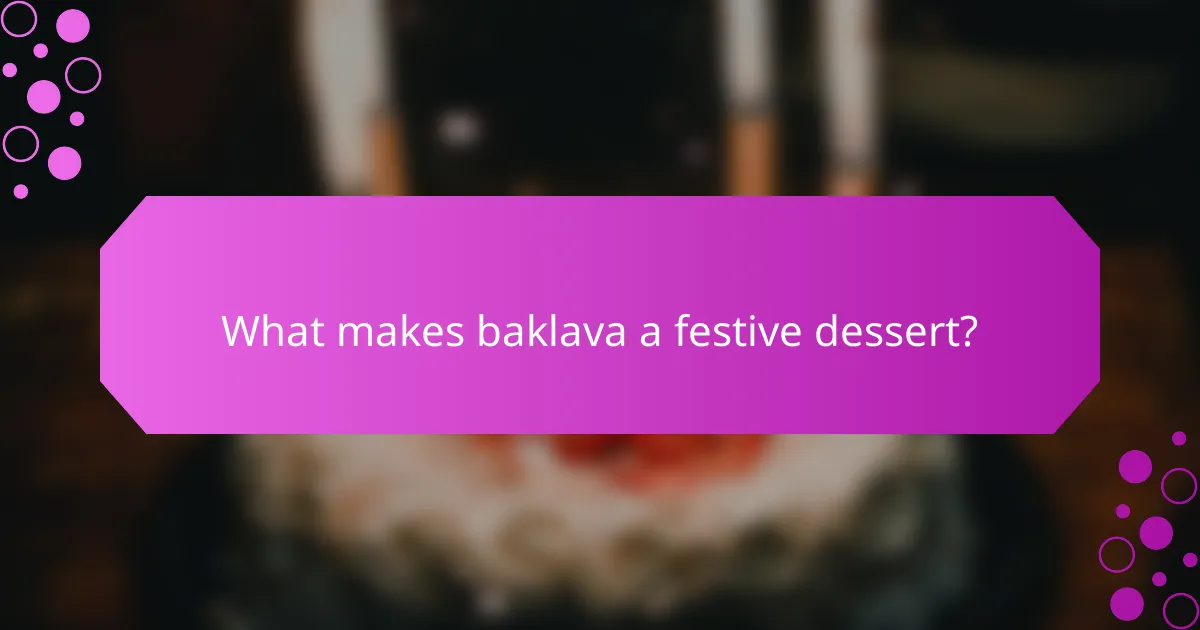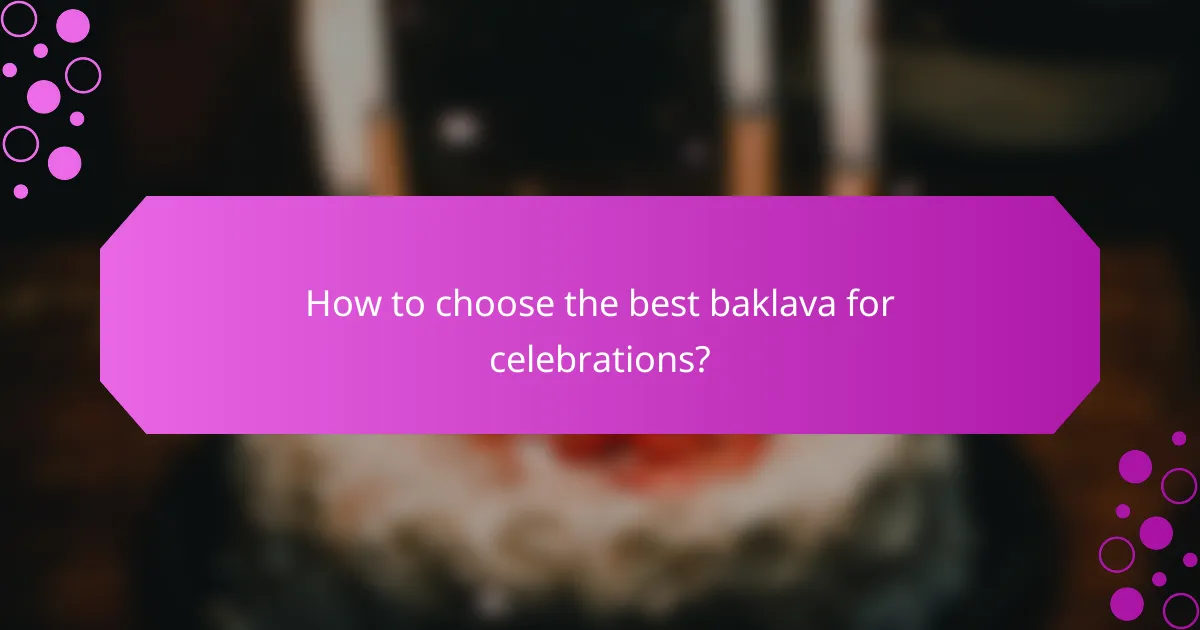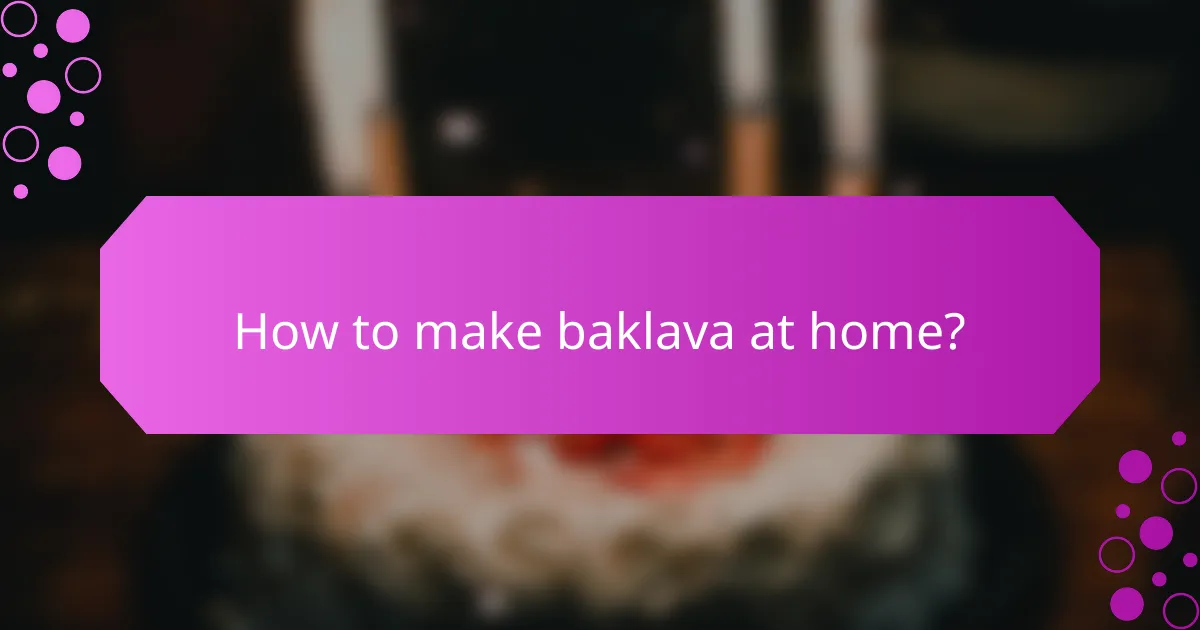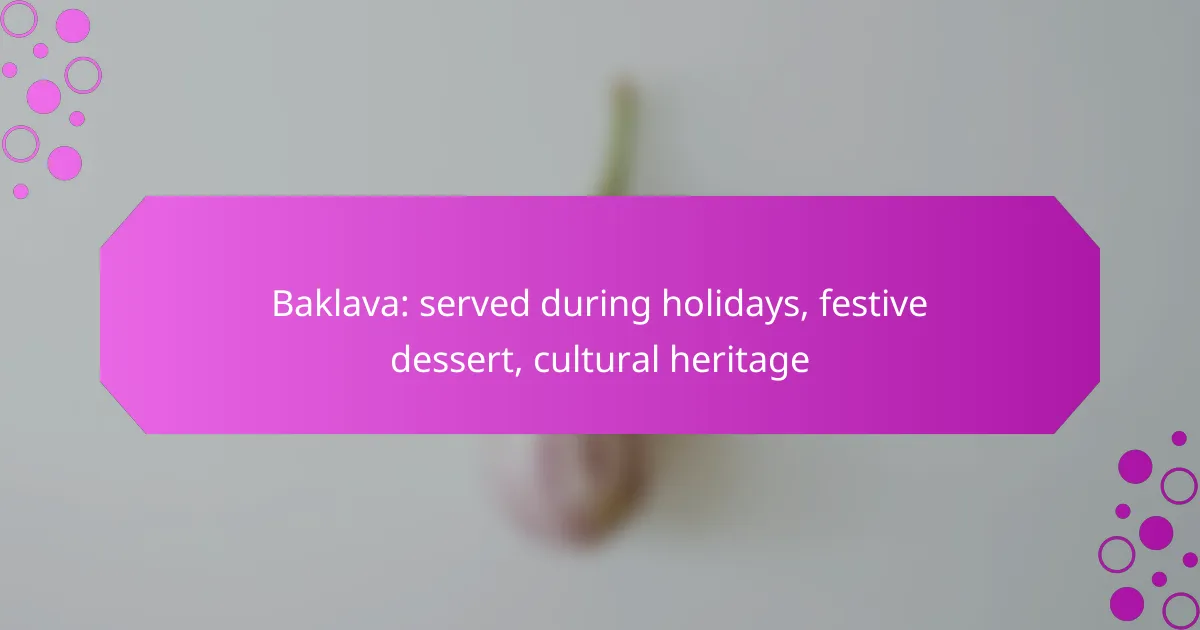Baklava is a rich and sweet pastry that embodies cultural heritage, particularly in the Middle East and Mediterranean regions. Traditionally served during holidays and special occasions, such as Ramadan and weddings, it symbolizes hospitality and celebration. Its intricate layers of flaky pastry, nuts, and syrup make it a festive dessert that brings joy and abundance to gatherings.

How is baklava served during holidays in Turkey?
In Turkey, baklava is a traditional dessert served during holidays, particularly during Ramadan and special celebrations like weddings. It is often presented as a symbol of hospitality and is enjoyed by family and guests alike.
Traditional serving methods
Baklava is typically cut into diamond or square shapes before serving, allowing for easy sharing among guests. It is often arranged on decorative platters, sometimes garnished with crushed pistachios or walnuts to enhance its visual appeal. In many households, it is customary to serve baklava warm, drizzled with syrup or honey for added sweetness.
Accompaniments and beverages
Baklava is commonly paired with Turkish tea or coffee, which complements its rich flavors. The bitterness of coffee balances the sweetness of the dessert, making it a popular choice. Additionally, some people enjoy baklava with a scoop of ice cream or a dollop of clotted cream, adding a creamy texture to the experience.
Regional variations
In Turkey, baklava varies by region, with different nuts and syrups used in its preparation. For instance, the Gaziantep region is famous for its pistachio baklava, while in Istanbul, walnuts are often the nut of choice. Each region may also have its unique twist on the syrup, with some incorporating rosewater or citrus for added flavor.

What makes baklava a festive dessert?
Baklava is considered a festive dessert due to its rich flavors, intricate preparation, and cultural significance during celebrations. Its layers of flaky pastry, nuts, and sweet syrup create a luxurious treat that symbolizes joy and abundance, making it a staple in many holiday traditions.
Symbolism in celebrations
Baklava often represents prosperity and happiness in various cultures. The act of sharing this dessert during gatherings signifies unity and generosity, reinforcing social bonds among family and friends. Its elaborate presentation and rich ingredients also reflect the importance of the occasion being celebrated.
In many Middle Eastern and Mediterranean cultures, baklava is seen as a symbol of hospitality. Offering baklava to guests is a way to honor them and demonstrate warmth, making it a key element in festive settings.
Popular occasions for serving
Baklava is commonly served during major holidays such as Ramadan, Eid, and Christmas. During Ramadan, it is often enjoyed as a sweet treat to break the fast, while at Eid celebrations, it is a favorite dessert to share with family and friends.
Other occasions include weddings, anniversaries, and cultural festivals, where baklava is featured prominently. Its rich taste and appealing presentation make it a popular choice for celebrations, ensuring it remains a cherished dessert across various cultures.

What is the cultural heritage of baklava?
Baklava is a rich, sweet pastry that holds significant cultural heritage across various regions, particularly in the Middle East and the Mediterranean. It symbolizes celebration and is often served during holidays and special occasions, reflecting the culinary traditions of the communities that cherish it.
Historical origins
The origins of baklava can be traced back to ancient civilizations, with roots in the Assyrian Empire around the 8th century BC. It evolved through various cultures, notably the Byzantine and Ottoman empires, which refined the recipe and popularized its consumption across Europe and Asia.
Traditional baklava consists of layers of filo pastry filled with chopped nuts and sweetened with syrup or honey. Each region has its unique twist, incorporating local ingredients and flavors, which adds to its rich history.
Influence on Mediterranean cuisine
Baklava has significantly influenced Mediterranean cuisine, becoming a staple dessert in many countries such as Greece, Turkey, and Lebanon. Its preparation methods and flavor profiles have inspired variations like Greek baklava, which often includes cinnamon and cloves, and Turkish baklava, known for its use of pistachios.
This dessert not only showcases the culinary techniques of layering and baking but also highlights the importance of communal dining and festive gatherings in Mediterranean cultures. Baklava is frequently served during holidays like Ramadan, Christmas, and weddings, reinforcing its role in cultural celebrations.

How to choose the best baklava for celebrations?
Selecting the best baklava for celebrations involves considering the quality of ingredients, the reputation of brands, and personal taste preferences. High-quality baklava should have a perfect balance of flaky pastry, rich nuts, and sweet syrup, making it a delightful festive dessert.
Ingredients to look for
When choosing baklava, prioritize fresh ingredients such as high-quality nuts like pistachios or walnuts, pure honey, and real butter. The phyllo dough should be thin and crispy, contributing to the overall texture.
Avoid baklava that contains artificial flavors or preservatives, as these can detract from the authentic taste. Look for products that highlight natural ingredients and traditional preparation methods.
Top brands in the market
Some well-regarded baklava brands include Gulluoglu, known for its authentic Turkish baklava, and Karam, which offers a variety of flavors and styles. These brands often use traditional recipes and high-quality ingredients, making them popular choices during festive occasions.
Additionally, local bakeries may offer homemade baklava that reflects regional flavors and techniques. Exploring these options can provide a unique taste experience for your celebrations.

What are the health considerations of baklava?
Baklava, while a delicious festive dessert, has several health considerations due to its rich ingredients and high calorie content. It is important to enjoy baklava in moderation, especially for those monitoring their sugar and fat intake.
Nutritional information
Baklava is typically high in calories, primarily due to its layers of phyllo dough, nuts, and syrup. A standard piece can contain around 150 to 300 calories, depending on the size and ingredients used. It is rich in fats, particularly healthy fats from nuts, but also contains significant amounts of sugar from the syrup.
In terms of macronutrients, baklava generally provides a good source of carbohydrates and protein, but it is low in fiber. For those interested in specific dietary needs, a piece of baklava may contain around 10-20 grams of sugar and 7-15 grams of fat.
Allergy concerns
Baklava commonly contains allergens such as nuts, gluten, and dairy, which can pose risks for individuals with specific allergies. Nuts like walnuts, pistachios, or almonds are often used, making it unsuitable for those with nut allergies.
Additionally, the phyllo dough is made from wheat, so it is not gluten-free. Some recipes may also include butter or milk, which could affect those with dairy sensitivities. Always check ingredient labels or inquire about preparation methods when consuming baklava in restaurants or gatherings.

How to make baklava at home?
Making baklava at home involves layering thin sheets of pastry with nuts and sweet syrup. This traditional dessert is not only delicious but also a rewarding culinary project that reflects cultural heritage.
Essential ingredients
To create authentic baklava, you will need a few key ingredients: phyllo dough, unsalted butter, a mix of nuts (such as walnuts, pistachios, or almonds), sugar, and honey. Additionally, cinnamon and water are often included to enhance flavor.
Using high-quality nuts and fresh phyllo dough is crucial for achieving the best texture and taste. Aim for about 400-500 grams of nuts and 250-300 grams of butter for a standard recipe that serves around 10-12 people.
Step-by-step recipe
Begin by preheating your oven to 175°C (350°F). Melt the butter and prepare a baking dish by brushing it with some of the melted butter. Layer about 10 sheets of phyllo dough in the dish, brushing each layer with butter. Then, spread a mixture of finely chopped nuts and sugar evenly over the top.
Continue layering phyllo and nut mixture until all ingredients are used, finishing with several layers of phyllo on top. Cut the baklava into diamond or square shapes before baking for about 45-50 minutes until golden brown. Once baked, pour a hot syrup made from sugar, water, and honey over the baklava and let it soak for several hours or overnight for the best flavor.

What are the best baklava variations to try?
The best baklava variations to try include traditional styles and modern twists, each offering unique flavors and textures. Popular options range from classic pistachio and walnut to innovative versions featuring chocolate or fruit fillings.
Traditional Baklava
Traditional baklava typically consists of layers of phyllo dough filled with finely chopped nuts, often walnuts or pistachios, and sweetened with honey or syrup. This classic version is a staple in many Middle Eastern and Mediterranean cultures, especially during holidays and festive occasions.
When enjoying traditional baklava, consider the balance of sweetness and nuttiness. The best baklava should have a crisp exterior and a rich, moist filling, often enhanced with spices like cinnamon or cardamom.
Modern Variations
Modern baklava variations have emerged, incorporating diverse ingredients and flavors. Options like chocolate baklava, which includes layers of chocolate ganache, or fruit-infused versions with berries or citrus, offer a contemporary twist on the classic dessert.
These innovative baklava styles can appeal to a broader audience, particularly those looking for unique dessert experiences. When trying modern variations, look for artisanal bakers who prioritize quality ingredients and craftsmanship.
Regional Specialties
Different regions have their own specialties when it comes to baklava. For instance, Greek baklava often features a honey syrup flavored with lemon, while Turkish baklava may include a heavier syrup and a variety of nuts.
Exploring regional baklava can enhance your appreciation for this dessert’s cultural heritage. Each variation reflects local tastes and traditions, making it worthwhile to sample baklava from various countries.
